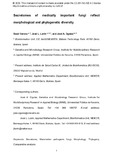Secretomes of medically important fungi reflect morphological and phylogenetic diversity
Fecha
2020Versión
Acceso abierto / Sarbide irekia
Tipo
Artículo / Artikulua
Versión
Versión aceptada / Onetsi den bertsioa
Impacto
|
|
10.1016/j.funbio.2020.07.011
Resumen
Secretome represents a main target for understanding the mechanisms of fungal adaptation. In the present study, we focus on the secretomes of fungi associated with infections in humans and other mammals in order to explore relationships between the diverse morphological and phylogenetic groups. Almost all the mammalian pathogenic fungi analyzed have secretome sizes smaller than 1000 proteins and, ...
[++]
Secretome represents a main target for understanding the mechanisms of fungal adaptation. In the present study, we focus on the secretomes of fungi associated with infections in humans and other mammals in order to explore relationships between the diverse morphological and phylogenetic groups. Almost all the mammalian pathogenic fungi analyzed have secretome sizes smaller than 1000 proteins and, secreted proteins comprise between 5% and 10% of the total proteome. As expected, the correlation pattern between the secretome size and the total proteome was similar to that described in previous secretome studies of fungi. With regard to the morphological groups, minimum secretome sizes of less than 250 secreted proteins and low values for the fraction of secreted proteins are shown in mammalian pathogenic fungi with reduced proteomes such as microsporidia, atypical fungi and some species of yeasts and yeast-like fungi (Malassezia). On the other hand, filamentous fungi have significantly more secreted proteins and the highest numbers are present in species of filamentous fungi that also are plant or insect pathogens (Fusarium verticilloides, Fusarium oxysporum and Basidiobolus meristosporus). With respect to phylogeny, there are also variations in secretome size across fungal subphyla: Microsporidia, Taphrinomycotina, Ustilagomycotina and Saccharomycotina contain small secretomes; whereas larger secretomes are found in Agaricomycotina, Pezizomycotina, Mucoromycotina and Entomophthoromycotina. Finally, principal component analysis (PCA) was conducted on the complete secretomes. The PCA results revealed that, in general, secretomes of fungi belonging to the same morphological group or subphyla cluster together. In conclusion, our results point out that in medically important fungi there is a relationship between the secretome and the morphological group or phylogenetic classification. [--]
Materias
Secretome,
Mammalian pathogenic fungi,
Morphology,
Phylogeny,
Comparative analysis
Editor
Elsevier British Mycological Society
Publicado en
Fungal Biology, 2020, 124(11), 915-923
Departamento
Universidad Pública de Navarra/Nafarroako Unibertsitate Publikoa. Institute for Multidisciplinary Research in Applied Biology - IMAB
Versión del editor
Entidades Financiadoras
This work was supported by research project RTI2018-099371-B-I00 of the Spanish National Research Plan and by additional institutional support from the Public University of Navarre, and the MCI for the Severo Ochoa Excellence accreditation (SEV-2016-0644).






